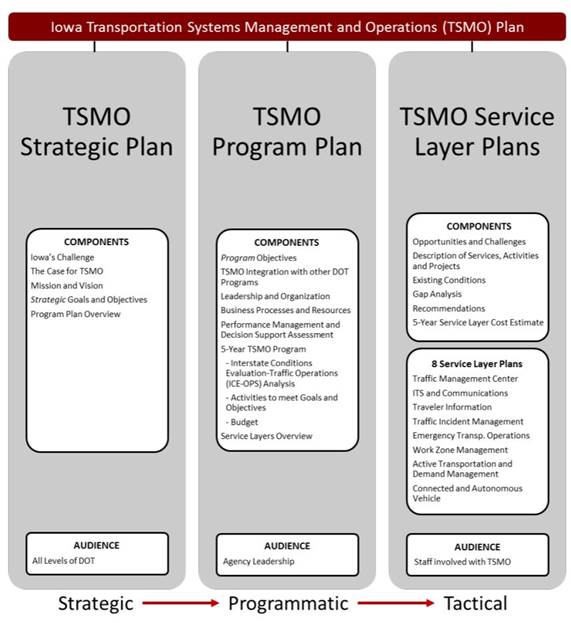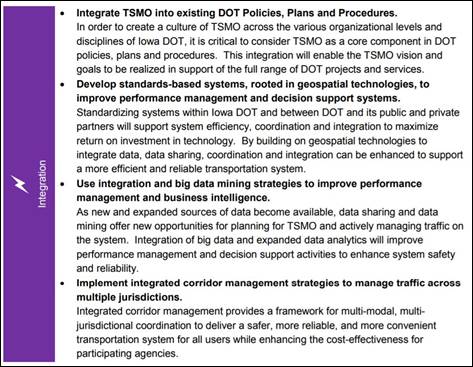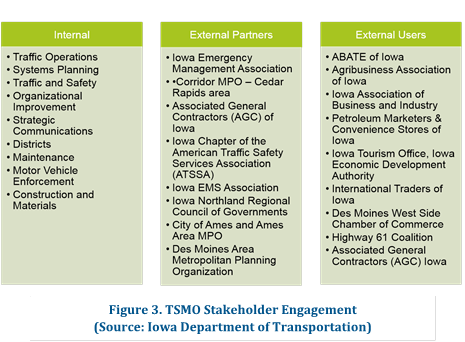US Department of Transportation
FHWA PlanWorks: Better Planning, Better Projects
Linking Planning and Operations
Iowa Department of Transportation
This case study is an excellent example of coordination in developing a Transportation Systems Management and Operations, or TSMO, Plan. Although Iowa DOT did not use PlanWorks, the PlanWorks Linking Planning and Operations Application will be very useful in helping other agencies collaborating for a similar purpose.
- The Iowa DOT manages a transportation system that serves more than three million people across ninety-nine counties.
- Metropolitan areas are linked by Interstate highways that are congested during the peak period, impacting both freight movement and commuters.
- Weather is a significant factor, with significant snowfall during the winter season, presenting operations challenges.
- Iowa DOT has adopted a transportation systems management and operations approach to develop near-term, cost-effective solutions to address system deficiencies and customer needs.
- Making TSMO a core function of the DOT has enabled the agency to effectively link planning and operations.
Executive Summary
The Iowa Department of Transportation (Iowa DOT) is a leader in linking planning and operations. Iowa DOT manages the State's transportation system that serves more than three million people across 99 counties. Although Iowa is largely rural—its largest city is Des Moines (Census 2010 population: 203,433)—travel between adjacent metropolitan areas during peak periods is congested and impacts freight movement, as well as commuters.
To address these congestion challenges and limited transportation resources, the Iowa DOT employs a transportation systems management and operations (TSMO) approach to improve its capability to manage the State's transportation system. Although TSMO has been an active part of Iowa DOT for many years, developing a multi-dimensional program and plan was a way to fully implement and integrate the approach. Spearheaded by the Office of Traffic Operations, the agency's TSMO Program took on a three-tiered planning effort comprised of a strategic plan, program plan, and service layer plans. These plans have helped to establish TSMO as a core agency function and supports the integration of operations into transportation planning.
Agency's Challenge
Historically, many State Departments of Transportation focused on delivering infrastructure capacity as their core function. Road capacity is often built out in many metropolitan areas and transportation funding is in limited supply. Faced with these changing realities, DOTs are moving to incorporate cost-effective, near-term solutions to optimize the existing transportation network and address customer needs more efficiently with TSMO strategies. For full and effective implementation, TSMO must be considered as an essential function that is vital to the mission of the DOT. Like other essential functions, TSMO can be integrated into the institutional structure of the agency.
Iowa DOT provides a notable example of TSMO program development, in which operations is linked with planning and programming processes to improve the agency's capability to manage the statewide transportation system. One of Iowa's primary challenges is non-recurring congestion caused by traffic incidents, work zones, inclement weather, and special events. Additionally, population projections indicate that Iowa's metropolitan areas will face increased congestion and capacity issues, and rural areas will experience increasingly limited transportation budgets. To support future economic development, Iowa needs to maintain an accessible, reliable, and well-connected transportation system. These current challenges and future trends underscore the value of TSMO to help the DOT "fine tune the performance of and proactively manage the state's transportation system." [1]
To this end, Iowa DOT developed a TSMO Program that is supported by a three-tiered plan focusing on strategic, programmatic, and service (i.e., tactical) elements as shown in Figure 1 below.
Figure 1. Iowa DOT's three-tiered TSMO planning process.

(Source: Iowa Department of Transportation)
Iowa DOT's TSMO Program planning efforts support integrated planning. Noteworthy activities are indicated below.
- LRP-1. Ensure that decision-makers, stakeholders, and the public have a clear understanding of TSMO and the value it adds to the transportation system.
- LRP-2. Incorporate a TSMO perspective into the development of a vision and goals that focus on system optimization, efficiency, and reliability.
- LRP-3. Modify traditional criteria methods and measures to allow TSMO strategies to be competitive with expansion activities.
- PRO-1. Identify funding opportunities available for non-capacity/operations projects (Congestion Mitigation and Air Quality Improvement Program, public-private partnerships, etc.).
- PRO-2. Ensure that methodology and criteria are applicable to TSMO projects.
- PRO-5. Assess whether the Draft TIP is compatible with the TSMO Program goals and objectives prior to public review and comment.
Development of the TSMO Plans
In developing its TSMO Program, Iowa DOT employed a methodical approach. First, it produced a TSMO Strategic Plan, which articulates transportation system challenges, the value of TSMO, and how it can address the identified challenges. The plan sets parameters for the TSMO Program with a vision, mission, and strategic goals and objectives, which are related to supporting the Iowa DOT's vision, mission, goals and core values. Integration and coordination are key components of the program to ensure that TSMO strategies are incorporated into each of the Iowa DOT's activities, including planning, design, construction, and maintenance.
Next, Iowa DOT developed a TSMO Program Plan that expands upon the TSMO strategy and focuses on program development. This plan addresses organizational matters, including leadership, agency structure, business processes, communications, performance management, resources, etc. With a focus on structure, the plan is critical to integrating TSMO across the Iowa DOT, and collaboration with external partners and stakeholders, as shown in Figure 2 below. The Program Plan—with emphasis on standardizing systems, data sharing, and multi-jurisdictional collaboration—lays the foundation for integrating operations into the planning and programming processes.
Figure 2. TSMO Program Plan Strategic Objective: Integration.

(Source: Iowa Department of Transportation)
Building on the program plan are eight activity-specific TSMO Service Layer Plans. The eight focus areas are:
- Traveler Information
- Traffic Incident Management
- ITS and Communications Systems
- Traffic Management
- Emergency Transportation and Operations
- Work Zone Management
- Active Transportation and Demand Management
- Connected and Autonomous Vehicle
The service plans are tactical; detailing specific TSMO services, activities and projects associated with each topic area. They provide a 5-year cost estimate for implementation and represent the customer focus element of the plan. In 2016 three of these layers were complete: ITS and Communications, Traveler Information, and Traffic Incident Management. The remaining service layers will be phased in over time, and all are anticipated to be complete by 2019...
Linking Planning and Operations
A TSMO approach is most effective when operations strategies are considered across planning and programming. There is an ongoing connection between the TSMO Program and long range planning: TSMO planning supports the Long Range Transportation Plan goals and objectives and also provides a basis for addressing priority needs. To fully implement the TSMO Program, priorities from the long range plan that include TSMO strategies must result in programmed projects. Traditionally project selection criteria do not adequately assess TSMO strategies—making it difficult for TSMO projects to compete with capacity projects. To effectively incorporate operations into programing, the project prioritization process must be modified to consider TSMO strategies along with all other options to address the need.
Iowa DOT's TSMO Program Plan includes the following recommendations to integrate TSMO during programming:
- Work with the Office of Program Management and the Project Scheduling Engineer to streamline the process for integrating ITS deployments into highway improvement projects in the 5-Year Program (Transportation Improvement Program).
- Identify alternative funding opportunities, such as federal or state grants, public-private partnerships, and research funding.
- Support efforts by MPOs to incorporate operations into regional planning
Iowa DOT has learned that both leadership and staff commitment and buy-in is necessary for a successful TSMO approach. Collaborating with others allows existing planning processes to be leveraged which builds organizational credibility. Better customer service and quality of life are the long-term expected outcomes.
Stakeholder Collaboration
Coordination and collaboration are key to Iowa DOT's TSMO Program, because the implementation and delivery of TSMO projects requires collaboration across the agency and with external partners. The Office of Traffic Operations led the development of the TSMO Program planning, and engaged stakeholders to provide input for TSMO planning.

Iowa held two Capability Maturity (CM) Workshops (2013 and 2016) which involved participants from the Districts and Central Office. The five-year goal is a combined CM score of 3.0, based on the 1.5 initial score. Goals and objectives were tested using focus groups of internal and external stakeholders as well as external users. As Figure 3 illustrates, stakeholders represent a diverse group of interests and perspectives. A TSMO Steering Committee was established with subcommittees including project delivery, training and communication, and work zone management. University partnerships are identified to support future data needs.
The eight individual service layers in the TSMO Program Plan represent the customer focus. In 2016 three of these layers were complete: ITS and Communications, Traveler Information, and Traffic Incident Management.
Key Outcomes
Iowa's TSMO Program planning efforts supports integrated, collaborative transportation decision-making at Iowa DOT. The development of the strategic, programmatic, and tactical plans has resulted in the identification of TSMO goals, objectives, strategies that can help frame questions that should be considered, capture stakeholder inputs, and provide data for an integrated planning process. The TSMO Program's focus on internal and external collaboration, helps to facilitate the engagement of stakeholders with an interest in operations in the broader planning and programming processes.
Recent activities and accomplishments include:
- 3rd Annual Traffic Incident Management (TIM) Conference
- Automated Vehicle Pilot
- New Transportation Management Center Software RFP
- Truck Parking Information Management System
- Statewide TIM Committee
- New TSMO Policies
For More Information
Contacts
Scott MarlerDirector of Traffic Operations
Iowa Department of Transportation
scott.marler@iowadot.us
